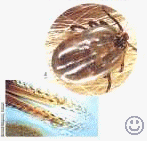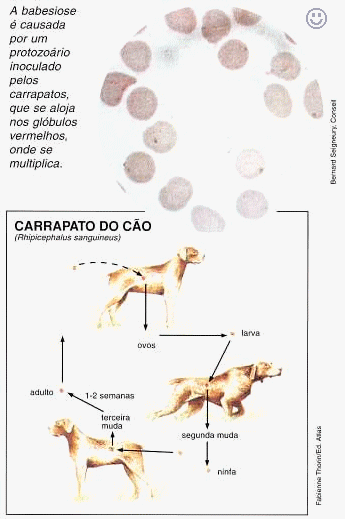BABESIOSE
Feared, with reason, for all the proprietors of dogs, the
babesiose or piroplasmose, as well as it was designated by the veterinarians, it
can be mortal. Although it is possible to cure her, it is better to prevent her,
as so much other diseases.
 Transmitted
by the ticks, the babesiose (formerly denominated piroplasmose or also "
nambiuvu ") it is a disease of the blood caused by the Babesia kennels, a
protozoan that it sponges the red globules and it destroys them, multiplying.
Therefore, the disease is accompanied of anemia (anemia hemolítica). It can be
mortal.
Transmitted
by the ticks, the babesiose (formerly denominated piroplasmose or also "
nambiuvu ") it is a disease of the blood caused by the Babesia kennels, a
protozoan that it sponges the red globules and it destroys them, multiplying.
Therefore, the disease is accompanied of anemia (anemia hemolítica). It can be
mortal.
The ticks prefer the hot and humid climates, as the one of
the Mediterranean basin or of the Tropics, where he/she is most of the seventy
known species. In Brazil, the babesiose is quite common in the states of the
Northeast Brazilian, and less common us of the South and Southeast
Cares with the ticks
The Rhipicephalus sanguineus is the popular tick of the dog.
However, eventually in the small farms, ranches, farms, etc., the one where
other animal species exist (gallinaceous, equine, pigs, etc.) the dog can come
to be sponged by other species of ticks (Argas miniatus, Dermacentor nitens).
The Rhipicephalus sanineus, of red brown coloration, is very cosmopolitan,
besides infesting the dogs, he is found in the environment (residences, kennels,
walls, madeirame of the roofs, windowsill of the doors, peels of trees, etc.)
The ticks and mainly your eggs are very sensitive to the incidence of the solar
rays and for that they take shelter in the openings, holes, depressions, etc.
The tick of the dog can walk on the man's body, however it is unable to sponge
him/it.
For
your characteristics, the ticks are obligatory and temporary parasites.
Obligatory, because they cannot live without the host, that provides them the
necessary blood for they continue your development cycle, once they settled in
your skin (areas where this is fine: ears, pleats of the abdomen, spaces
interdigitais). Temporary, because, when they finish sucking the blood, the
acarids abandon the host.
Each adult female tick is capable to put between 3.000 and
5.000 eggs, after the posture and incubation, that happen in the environment,
these eggs will create the larvas hexápodes (that possess 3 equal of paws)
that are very active and resistant. They will seek a dog immediately for if
they feed. After an ingestion of blood that can last from 3 to 6 days, the
replete larva is loosened and it falls, and he/she becomes a nymph aclópode
(with 4 equal of paws), this nymph for your time will also seek a dog to feed
and once satiated it will fall and it will suffer a new change to change in an
adult young sexuado, equally oclópode. That young one for your time will also
seek a dog to feed and to become adult. The acasalamento is produced on the
host, during the ingestion of blood, that can last up to ten days. Then, the
replete female of blood leaves in search of a favorable way to put the eggs
(soils, barns, holes in the roofs, etc.).
 The tick is infected when he/she drinks blood of a sick dog
or chronic bearer and, once ingested the babésias, these settle, seletivamente,
in the ovarian fabric of the female ticks, and they contaminate the eggs, where
they multiply for binary division. After they have contaminated the several
fabrics of the larvas and of the nymphs, the protozoa notice in the adult,
mainly in the glàndulases you salivate, where they multiply actively. This
location favors the inoculation of the babésias when the tick notices in the
skin of the host.
The tick is infected when he/she drinks blood of a sick dog
or chronic bearer and, once ingested the babésias, these settle, seletivamente,
in the ovarian fabric of the female ticks, and they contaminate the eggs, where
they multiply for binary division. After they have contaminated the several
fabrics of the larvas and of the nymphs, the protozoa notice in the adult,
mainly in the glàndulases you salivate, where they multiply actively. This
location favors the inoculation of the babésias when the tick notices in the
skin of the host.
The sick dog
To the symptoms, easily perceptible, and that they translate
a serious anemia, they are increased, sometimes, disturbances of the
coagulation, sharp renal inadequacy and nervous disturbances.
Direct or indirectly, the Babesia kennels are in the origin
of all those symptoms that, in the treatment lack, they can take to the death.
The diagnosis of the canine babesiose bases on the discovery and in the location
of the parasite, through microscope, in esfregaços sangüíneos. The disease
doesn't check any durable immunity and the relapses can be frequent leaving,
sometimes, serious hepatic and renal sequels
The Cure
The treatment of the babesiose holds two aspects. On one
side, it combats the parasite causador and, for other, it corrects the disorders
and complications produced by the disease.
Nowadays, the veterinarians have at your disposal
piroplasmicidas capable to destroy the parasite. During the minutes that they
are followed to your application, secondary effects can appear but that don't
present any danger. The treatment of the complications of the disease, that is
indispensable, habitually consists of the correction of the renal inadequacy
(for different means, among the ones which the hemodiálise, in other words, the
artificial kidney). The times, it is necessary to treat the disturbances of the
coagulation, the jaundice...
Prevention
As much the owner's efforts as the one of the veterinarian
they should seek, aboveall, to prevent the disease struggling, on one side,
against the vehicles of the canine babesiose, in other words, the ticks. In
Europe a vaccine exists however unhappily she is not very effective. The
prophylaxis sanitãria (it struggles against the ticks) it imposes the
desparasitação, as much of the polluted places as of the own animal. For this
last one, it is had numerous means: powders, sprays, baths antiparasitários,
collars, oral medicines. Some chemical substances, usually used, they are
toxicant and they have secondary effects. And better not to use such products
without the approval of the veterinarian. It is very important the environmental
combat, because as well as the fleas they use the dog as source of victuals.
Quite effective it is the employment of " fire "
broom or " it throws fires " on walls, kennels, bed frames, ground,
windowsills, because it radically eliminates all the phases of the parasite.
Symptoms that don't deceive
Some tick bit your dog? The most careful is to observe the
animal during three or four days. The disease is translated for:
OUR collection FRIENDS, THE DOGS
 Transmitted
by the ticks, the babesiose (formerly denominated piroplasmose or also "
nambiuvu ") it is a disease of the blood caused by the Babesia kennels, a
protozoan that it sponges the red globules and it destroys them, multiplying.
Therefore, the disease is accompanied of anemia (anemia hemolítica). It can be
mortal.
Transmitted
by the ticks, the babesiose (formerly denominated piroplasmose or also "
nambiuvu ") it is a disease of the blood caused by the Babesia kennels, a
protozoan that it sponges the red globules and it destroys them, multiplying.
Therefore, the disease is accompanied of anemia (anemia hemolítica). It can be
mortal. The tick is infected when he/she drinks blood of a sick dog
or chronic bearer and, once ingested the babésias, these settle, seletivamente,
in the ovarian fabric of the female ticks, and they contaminate the eggs, where
they multiply for binary division. After they have contaminated the several
fabrics of the larvas and of the nymphs, the protozoa notice in the adult,
mainly in the glàndulases you salivate, where they multiply actively. This
location favors the inoculation of the babésias when the tick notices in the
skin of the host.
The tick is infected when he/she drinks blood of a sick dog
or chronic bearer and, once ingested the babésias, these settle, seletivamente,
in the ovarian fabric of the female ticks, and they contaminate the eggs, where
they multiply for binary division. After they have contaminated the several
fabrics of the larvas and of the nymphs, the protozoa notice in the adult,
mainly in the glàndulases you salivate, where they multiply actively. This
location favors the inoculation of the babésias when the tick notices in the
skin of the host.